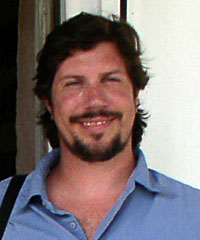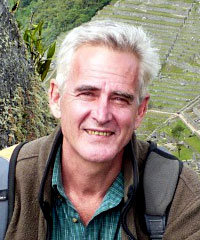Lecture Offerings from MEC
Maya Exploration Center offers a variety of public lectures for academic audiencs. The lectures are one-hour Power Point presentations delivered by our renowned archaeologists and anthropologists. Each of our speakers is a well-known expert in their field. Our seasoned professionals deliver scholarly presentations in engaging and entertaining ways. Our presentations are intended for campus event centers and unions as well as museums.
They have appeared on the National Geographic Channel, the History Channel, the Discovery Channel, NBC Nightly News, the Fox Channel, Japanese Public Television, the Teaching Company's "Great Courses" and multiple independent documentaries.
-
Dr. EDWIN BARHART

Shamanism in the Art and Iconography of Ancient Peru
Schedule this lectureThere are tens of thousands of beautiful pieces of art from pre-Columbian Peru, but their meanings and iconography remain mostly a mystery to this day. Traditional writing did not exist in ancient South America, so the messages encoded in their art are vital clues to understanding who they were and how they lived. Themes including warfare, human sacrifice, erotic sex, and a pantheon of bizarre deities have been noted, but there's a deeper layer – one of the shamanic ability to contact the supernatural world. Even in iconography traditionally interpreted as violence or sex, there is an underlying element of shamanism that may belie the true messages their ancient artists intended to convey.
This lecture presents a fascinating reinterpretation of ancient Peruvian art, revealing shamanic healing ceremonies, the calling of supernatural spirits, and how decapitation is not execution, but actually about enslaving the souls of one's enemies. A powerful deity will be revealed, a jaguar-like being who emerged from his lair in the Amazon thousands of years ago. From the origins of civilization in the Andes, all the way up through Inca times, the Fanged Deity was the one true god of the shamans depicted in ancient Peruvian art, an all knowing and all powerful creator deity who has been hidden in the shadows of misinterpretation until the groundbreaking work of your presenter, Dr. Edwin Barnhart.

Archaeoastronomy in the Ancient Ruins of Angkor Wat, Cambodia - The Zenith Passage
Schedule this lectureAround 1300 AD, the City of Angkor in Cambodia was likely the largest city on Earth. Recent studies have finally found a way to estimate its ancient population and discovered its citizens numbered almost 1 million people! Despite that amazing fact, very little is known about the Khmer culture people who lived there. The urban complex spans almost 1000 square kilometers, most of which is still hidden underneath dense rain forest overgrowth. Years of domination by the Khmer Rouge in the mid twenty century and the land mines they left behind prevented archaeology from reaching Angkor until just a few decades ago. Even know, as the ruins are open for tourism and protected by the Cambodian government, many questions remain unanswered. One of those questions is what they knew about astronomy and Dr. Barnhart is hot on the trail.
Over the course of two expeditions to Angkor, he has discovered that the temples produce spectacular displays of shadow and sunlight, illuminating their inner altars and statues on the day of zenith passage. During this presentation, he will show the photos of those light displays, explain how they relate to ancient astronomy, and present his grounds breaking theories on why zenith passage was so important to the ancient Khmer.

Maya Hieroglyphs - The Story of How the Code was Finally Broken
Schedule this lectureFive hundred years ago, Spanish conquistadors swept like a storm through Mexico and Central America virtually ending Maya civilization. European diseases wiped out 90% of the population in the first 50 years after contact and the survivors where Christianized and enslaved. When this happened, Maya hieroglyphic writing, one of only five original written languages ever created, vanished from the Earth. For centuries they lay hidden in the jungle, carved on monuments that were little more than curiosities to early explorers. Even as the age of archaeology began in the late 1800's, those that studied them had no idea what they said.
The beginnings of true decipherment began not in Mexico, but in a humble office of a brilliant scholar in Moscow. This lecture chronicles the strange set of stories and coincidences that led to the final breaking of the Maya code in 1973 and how the Maya are now speaking from the past to tell us who they were in their own words.
-
Dr. Christopher powell

The Shapes of the Maya Cosmos - Concerning a Greater Ancient American Cosmology
Schedule this lectureThis presentation explores the fundamental characteristics of the Maya's profound understanding of the geometry of nature - the very geometries employed by their "Maker, Modeler, mother-father of life," in creating the universe. Ethnographical investigations and examinations of Maya art and architecture are used here to demonstrate how the Maya today, and for thousands of years, have consciously emulated their creator by using these very same geometries to lay out and design their own creations. These examples range from the simple geometries used to lay out their modern houses, to the complex geometrical formulae used to design the great pyramids and temples and the exquisite works of art in the long abandoned ruins of their magnificent ceremonial centers.
The presentation concludes with an exploration of Maya concepts of the geometry of time and space. Evidence is presented that indicates that shared concepts of geometry and astronomy may well have driven the Maya, their Mesoamerican neighbours, and even the Inca in South America to travel great distances to place certain ceremonial centers at specific latitudes. -
Dr. Michael Grofe

The Recipe for Rebirth - Chocolate and the Ancient Maya
Schedule this lectureDr. Michael Grofe shares his research on the history and mythology of cacao as a sacred "food of the gods" from the Ancient Maya of the rainforests of Central America. While chocolate is one of the most popular and cherished of all foods, many are unaware of the fascinating history and mythology of chocolate from the Ancient Maya. In the K'iche' Maya Popol Vuh, the self-sacrifice of the Hero Twins in the underworld parallels the stages of cacao processing: entrance into the underworld (burial, fermentation), burning (roasting), grinding of their bones on a metate, and pouring them into water. Subsequently, the twins are reborn as two fish, which provides a compelling play on words for the Maya word kakaw. Dr. Grofe will explore this fascinating story, while also explaining its relationship to the movements of the planet Venus and its appearance as morning star–an event imbued with rich, symbolic significance for the peoples of Mesoamerica.

At the Edge of the Sky - Naked Eye Astronomy among the Ancient Maya
Schedule this lectureDr. Michael Grofe shares his original research on the Copán Baseline, which describes an observation of the Orion Nebula "at the edge of the sky" in 652 AD at the same position on the horizon as the sunrise. In the center of a cosmologically significant Maya constellation known as the Three Hearthstones, the Orion Nebula is described by contemporary Maya as the smoke from a fire that was lit in this hearth. The Copán Baseline, along with other Classic Maya texts suggest that this hearth was the birthplace of the sun.
Dr. Grofe considers the evidence that multiple astronomical observations and their associated deep time intervals in Maya hieroglyphic texts incorporated precise astronomical calculations of solar, lunar, and planetary movements, with a substantial emphasis on the measurement of the sidereal year and its ability to shift the seasonal position of the sun among the stars. In addition, these texts suggest that the mythological significance of numerous Maya deep time events derives from the symbolic progression of the agricultural year, while New Year's rituals among various Maya groups similarly reflect the renewals of larger cosmological cycles.






